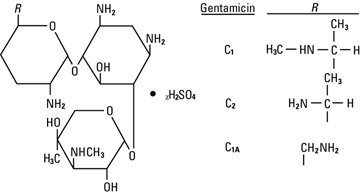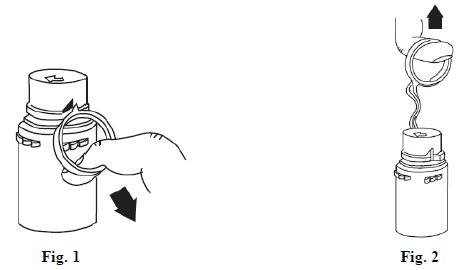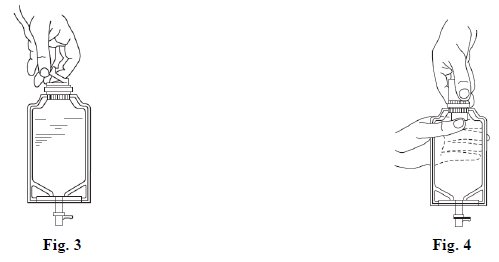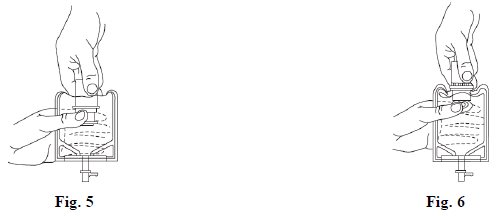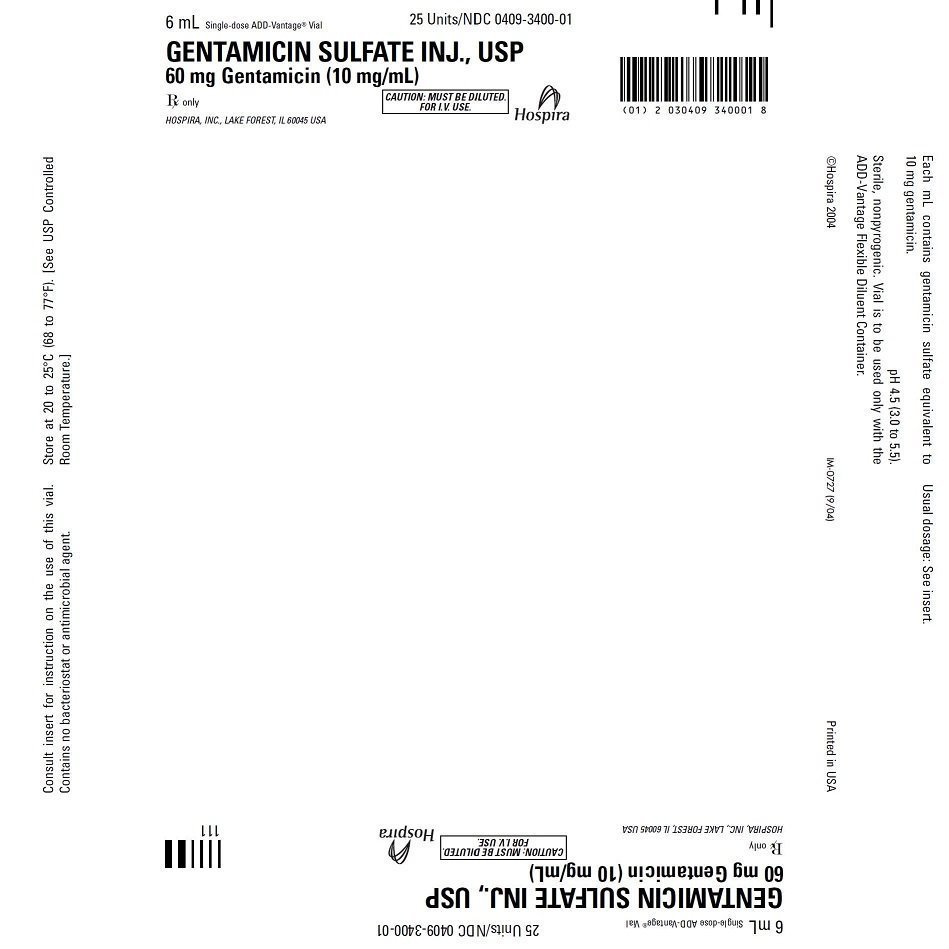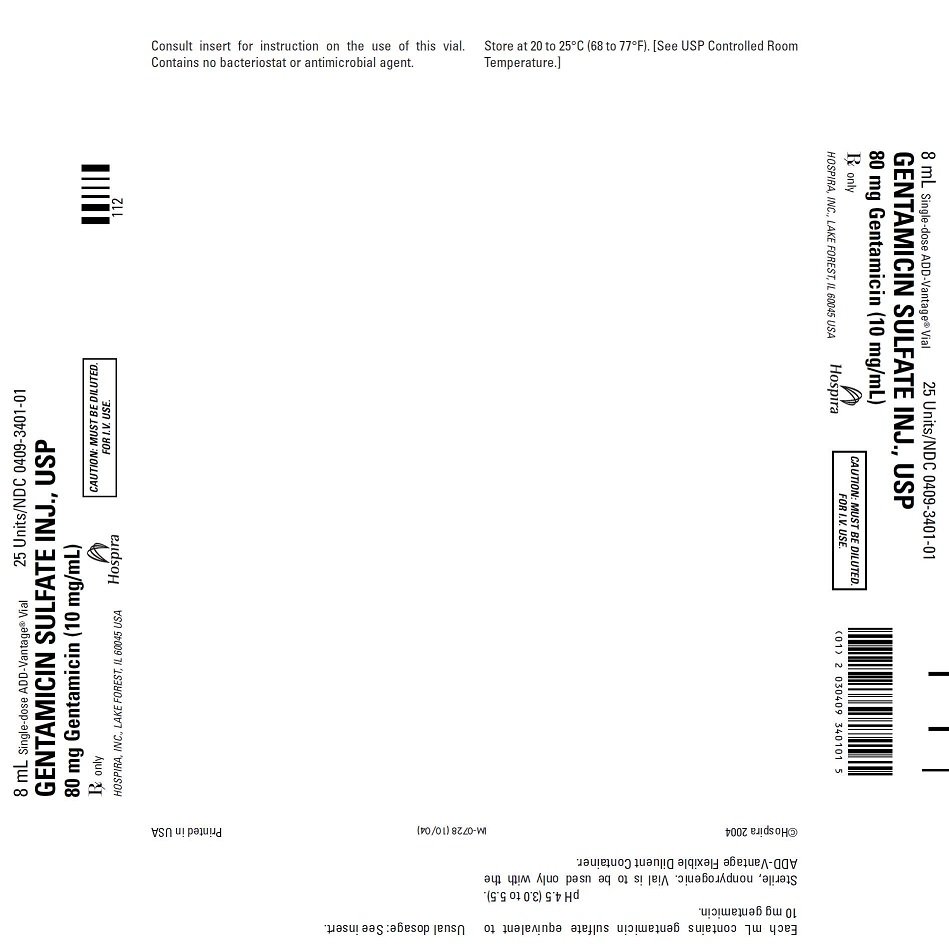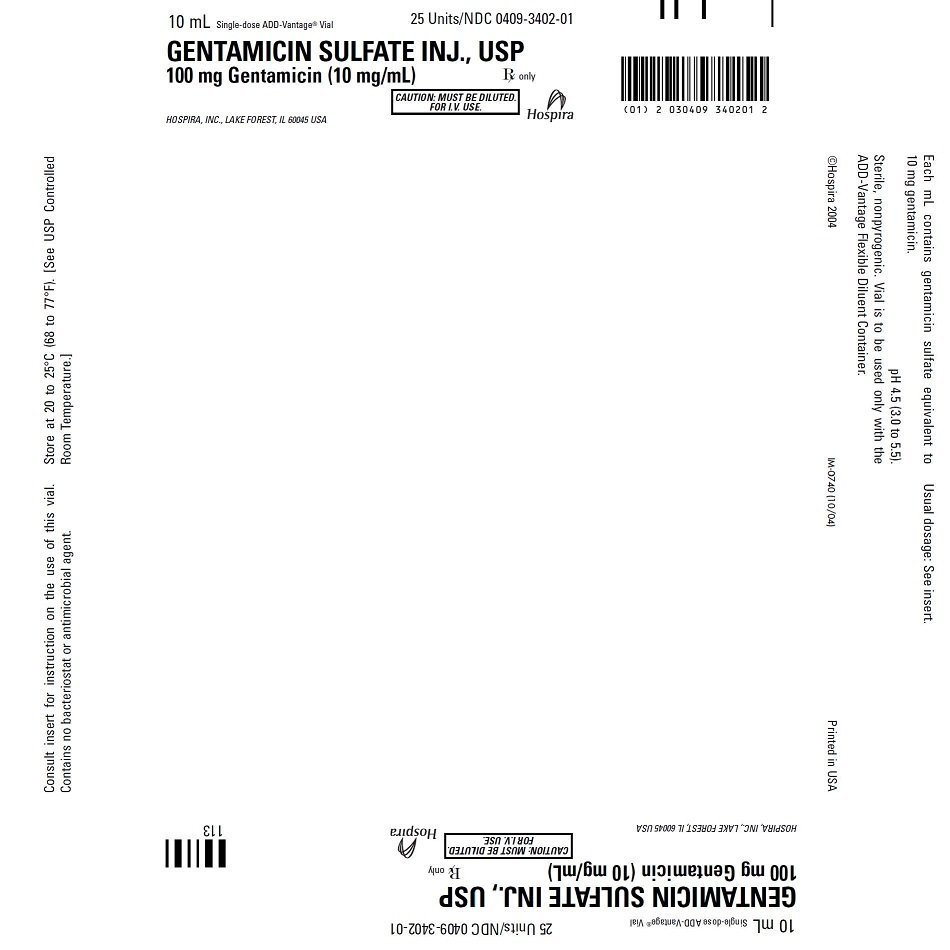Gentamicin Sulfate Injection Concentrate: Package Insert / Prescribing Info
Package insert / product label
Generic name: gentamicin sulfate
Dosage form: injection, solution, concentrate
Drug class: Aminoglycosides
Medically reviewed by Drugs.com. Last updated on Mar 25, 2024.
On This Page
Gentamicin Sulfate
Injection, USP
10 mg Gentamicin/mL
FOR INTRAVENOUS INFUSION
ONLY AFTER DILUTION
The Vial Contains Gentamicin Sulfate Injection, USP
Equivalent to 60, 80, or 100 mg Gentamicin.
ADD-Vantage™ Vial
To reduce the development of drug-resistant bacteria and maintain the effectiveness of gentamicin and other antibacterial drugs, gentamicin should be used only to treat or prevent infections that are proven or strongly suspected to be caused by bacteria.
WARNINGS
Patients treated with aminoglycosides should be under close clinical observation because of the potential toxicity associated with their use.
As with other aminoglycosides, gentamicin sulfate is potentially nephrotoxic. The risk of nephrotoxicity is greater in patients with impaired renal function and in those who receive high dosage or prolonged therapy.
Neurotoxicity manifested by ototoxicity, both vestibular and auditory, can occur in patients treated with gentamicin sulfate primarily in those with pre-existing renal damage and in patients with normal renal function treated with higher doses and/or for longer periods than recommended. Aminoglycoside-induced ototoxicity is usually irreversible. Other manifestations of neurotoxicity may include numbness, skin tingling, muscle twitching and convulsions.
Renal and eighth cranial nerve function should be closely monitored, especially in patients with known or suspected reduced renal function at onset of therapy and also in those whose renal function is initially normal but who develop signs of renal dysfunction during therapy. Urine should be examined for decreased specific gravity, increased excretion of protein, and the presence of cells or casts. Blood urea nitrogen, serum creatinine, or creatinine clearance should be determined periodically. When feasible, it is recommended that serial audiograms be obtained in patients old enough to be tested, particularly high-risk patients. Evidence of ototoxicity (dizziness, vertigo, tinnitus, roaring in the ears or hearing loss) or nephrotoxicity requires dosage adjustment or discontinuance of the drug. As with the other aminoglycosides, on rare occasions changes in renal and eighth cranial nerve function may not become manifest until soon after completion of therapy.
Serum concentrations of aminoglycosides should be monitored when feasible to assure adequate levels and to avoid potentially toxic levels. When monitoring gentamicin peak concentrations, dosage should be adjusted so that prolonged levels above 12 mcg/mL are avoided. When monitoring gentamicin trough concentrations, dosage should be adjusted so that levels above 2 mcg/mL are avoided. Excessive peak and/or trough serum concentrations of aminoglycosides may increase the risk of renal and eighth cranial nerve toxicity. In the event of overdose or toxic reactions, hemodialysis may aid in the removal of gentamicin from the blood, especially if renal function is, or becomes, compromised. The rate of removal of gentamicin is considerably lower by peritoneal dialysis than it is by hemodialysis.
Concurrent and/or sequential systemic or topical use of other potentially neurotoxic and/or nephrotoxic drugs, such as cisplatin, cephaloridine, kanamycin, amikacin, neomycin, polymyxin B, colistin, paromomycin, streptomycin, tobramycin, vancomycin, and viomycin, should be avoided.
Other factors which may increase patient risk to toxicity are advanced age and dehydration.
The concurrent use of gentamicin with potent diuretics, such as ethacrynic acid or furosemide, should be avoided, since certain diuretics by themselves may cause ototoxicity. In addition, when administered intravenously, diuretics may enhance aminoglycoside toxicity by altering the antibiotic concentration in serum and tissue.
Aminoglycosides can cause fetal harm when administered to a pregnant woman (See WARNINGS).
Gentamicin Sulfate Injection Concentrate Description
Gentamicin Sulfate Injection, USP is a sterile, nonpyrogenic solution of gentamicin sulfate in water for injection. Each milliliter (mL) contains gentamicin sulfate equivalent to 10 mg gentamicin base in water for injection. The pH is 4.5 (3.0 to 5.5). Gentamicin Sulfate Injection, USP is oxygen sensitive.
The solutions contain no bacteriostat, antimicrobial agent (except gentamicin) or buffer and are intended for use as a single-dose injection only with the ADD-Vantage Flexible Diluent Container.
Gentamicin Sulfate Injection, USP in the ADD-Vantage system is intended for intravenous administration only after dilution.
Gentamicin is classified as an aminoglycoside antibiotic and is derived from Micromonospora purpurea, an actinomycete.
The chemical name for gentamicin C1A is: 0-3-Deoxy-4-C-methyl-3-(methylamino)-β-L-arabinopyranosyl-(1 → 6)-0-[2,6-diamino-2,3,4,6-tetradeoxy-α-D-erythro-hexopyranosyl-(1 → 4)]-2-deoxy-D-streptamine.
Gentamicin Sulfate, USP is chemically designated gentamicin sulfate, a white to buff powder soluble in water. It has the following structural formula:
Gentamicin Sulfate Injection Concentrate - Clinical Pharmacology
After intramuscular administration of gentamicin sulfate, peak serum concentrations usually occur between 30 to 60 minutes and serum levels are measurable for 6 to 8 hours. When gentamicin is administered by intravenous infusion over a two-hour period, the serum concentrations are similar to those obtained by intramuscular administration.
In patients with normal renal function, peak serum concentrations of gentamicin (mcg/mL) are usually up to four times the single intramuscular dose (mg/kg); for example, a 1 mg/kg injection in adults may be expected to result in a peak serum concentration up to 4 mcg/mL; a 1.5 mg/kg dose may produce levels up to 6 mcg/mL. While some variation is to be expected due to a number of variables such as age, body temperature, surface area and physiologic differences, the individual patient given the same dose tends to have similar levels in repeated determinations. Gentamicin administered at 1 mg/kg every eight hours for the usual 7- to 10-day treatment period to patients with normal renal function does not accumulate in the serum.
Gentamicin, like all aminoglycosides, may accumulate in the serum and tissues of patients treated with higher doses and for prolonged periods, particularly in the presence of impaired renal function. In adult patients, treatment with gentamicin dosages of 4 mg/kg/day or higher for seven to ten days may result in a slight, progressive rise in both peak and trough concentrations. In patients with impaired renal function, gentamicin is cleared from the body more slowly than in patients with normal renal function. The more severe the impairment, the slower the clearance.
Dosage must be adjusted.
Since gentamicin is distributed in extracellular fluid, peak serum concentrations may be lower than usual in adult patients who have a large volume of this fluid. Serum concentrations of gentamicin in febrile patients may be lower than those in afebrile patients given the same dose. When body temperature returns to normal, serum concentrations of the drug may rise. Febrile and anemic states may be associated with a shorter than usual serum half-life. (Dosage adjustment is usually not necessary.) In severely burned patients, the half-life may be significantly decreased and resulting serum concentrations may be lower than anticipated from the mg/kg dose.
Protein binding studies have indicated that the degree of gentamicin binding is low. Depending upon the methods used for testing, this may be between 0 and 30%.
After initial administration to patients with normal renal function, generally 70% or more of the gentamicin dose is recoverable in the urine in 24 hours; concentrations in urine above 100 mcg/mL may be achieved. Little, if any, metabolic transformation occurs; the drug is excreted principally by glomerular filtration. After several days of treatment, the amount of gentamicin excreted in the urine approaches the daily dose administered. As with other aminoglycosides, a small amount of the gentamicin dose may be retained in the tissues, especially in the kidneys. Minute quantities of aminoglycosides have been detected in the urine weeks after drug administration was discontinued. Renal clearance of gentamicin is similar to that of endogenous creatinine.
In patients with marked impairment of renal function, there is a decrease in the concentration of aminoglycosides in urine and in their penetration into defective renal parenchyma. This decreased drug excretion, together with the potential nephrotoxicity of aminoglycosides, should be considered when treating such patients who have urinary tract infections.
Probenecid does not affect renal tubular transport of gentamicin.
The endogenous creatinine clearance rate and the serum creatinine level have a high correlation with the half-life of gentamicin in serum. Results of these tests may serve as guides for adjusting dosage in patients with renal impairment (See DOSAGE AND ADMINISTRATION).
Following parenteral administration, gentamicin can be detected in serum, lymph, tissues, sputum, and in pleural, synovial, and peritoneal fluids. Concentrations in renal cortex sometimes may be eight times higher than the usual serum levels. Concentrations in bile, in general, have been low and have suggested minimal biliary excretion. Gentamicin crosses the peritoneal as well as the placental membranes. Since aminoglycosides diffuse poorly into the subarachnoid space after parenteral administration, concentrations of gentamicin in cerebrospinal fluid are often low and dependent upon dose, rate of penetration and degree of meningeal inflammation. There is minimal penetration of gentamicin into ocular tissues following intramuscular or intravenous administration.
Microbiology
Mechanism of Action
Gentamicin, an aminoglycoside, binds to the prokaryotic ribosome, inhibiting protein synthesis in susceptible bacteria. It is bactericidal in vitro against Gram-positive and Gram-negative bacteria.
Mechanism of Resistance
Bacterial resistance to gentamicin is generally developed slowly. Bacteria resistant to one aminoglycoside may be resistant to one or more other aminoglycosides. The following bacteria are usually resistant to the aminoglycosides, including gentamicin: most streptococcal species (including Streptococcus pneumoniae and the Group D streptococci), most enterococcal species (including Enterococcus faecalis, E. faecium, and E. durans), and anaerobic organisms, such as Bacteroides species and Clostridium species.
Aminoglycosides are known to be not effective against Salmonella and Shigella species in patients. Therefore, in vitro susceptibility test results should not be reported.
Interactions with Other Antimicrobials
In vitro studies show that an aminoglycoside combined with an antibiotic that interferes with cell wall synthesis may act synergistically against some enterococcal strains. The combination of gentamicin and penicillin G has a synergistic bactericidal effect against strains of Enterococcus faecalis, E. faecium and E. durans. An enhanced killing effect against many of these strains has also been shown in vitro with combinations of gentamicin and ampicillin, carbenicillin, nafcillin or oxacillin.
The combined effect of gentamicin and carbenicillin is synergistic for many strains of Pseudomonas aeruginosa. In vitro synergism against other Gram-negative organisms has been shown with combinations of gentamicin and cephalosporins.
Gentamicin may be active against clinical isolates of bacteria resistant to other aminoglycosides.
Antibacterial Activity
Gentamicin has been shown to be active against most of the following bacteria, both in vitro and in clinical infections [see Indications and Usage].
Gram-Positive Bacteria
Staphylococcus species
Gram-Negative Bacteria
Citrobacter species
Enterobacter species
Escherichia coli
Klebsiella species
Proteus species
Serratia species
Pseudomonas aeruginosa
Susceptibility Test Methods
When available, the clinical microbiology laboratory should provide cumulative results of the in vitro susceptibility tests for antimicrobial drugs used in local hospitals and practice areas to the physician as periodic reports that describe the susceptibility profile of nosocomial and community-acquired pathogens. These reports should aid the physician in selecting an antimicrobial drug for treatment.
Dilution technique
Quantitative methods are used to determine antimicrobial minimal inhibitory concentrations (MICs). These MICs provide estimates of the susceptibility of bacteria to antimicrobial compounds. The MICs should be determined using a standardized test method.1, 3 Standardized procedures are based on a dilution method (broth or agar) or equivalent with standardized inoculum concentrations and standardized concentrations of gentamicin powder. The MIC values should be interpreted according to the criteria provided in Table 1.
Diffusion technique
Quantitative methods that require measurement of zone diameters also provide reproducible estimates of the susceptibility of bacteria to antimicrobial compounds. The zone size should be determined using a standardized test method. The standardized procedure requires the use of standardized inoculum concentrations and paper disks impregnated with 10 mcg of gentamicin.2, 3 The disk diffusion values should be interpreted according to the criteria provided in Table 1.
| S = susceptible, I = intermediate, R = resistant a For Salmonella and Shigella spp., aminoglycosides may appear active in vitro but are not effective clinically; the results should not be reported as susceptible b For staphylococci that test susceptible, aminoglycosides are used only in combination with other active agents that test susceptible |
||||||
|
Pathogen |
Susceptibility Interpretive Criteria |
|||||
|
Minimal inhibitory |
Zone diameter |
|||||
|
S |
I |
R |
S |
I |
R |
|
|
Enterobacteriaceaea |
≤ 4 |
8 |
≥16 |
≥ 15 |
13 to 14 |
≤ 12 |
|
Pseudomonas aeruginosa |
≤ 4 |
8 |
≥16 |
≥ 15 |
13 to 14 |
≤ 12 |
|
Staphylococcus speciesb |
≤ 4 |
8 |
≥16 |
≥ 15 |
13 to 14 |
≤ 12 |
A report of Susceptible (S) indicates that the antimicrobial is likely to inhibit growth of the pathogen if the antimicrobial compound reaches the concentration usually achievable at the infection site necessary to inhibit growth of the pathogen. A report of Intermediate (I) indicates that the result should be considered equivocal, and if the microorganism is not fully susceptible to alternative clinically feasible drugs, the test should be repeated. This category implies possible clinical applicability in body sites where the drug is physiologically concentrated or in situations where a high dosage of the drug can be used. This category also provides a buffer zone that prevents small uncontrolled technical factors from causing major discrepancies in interpretation. A report of Resistant (R) indicates that the antimicrobial is not likely to inhibit growth of the pathogen if the antimicrobial compound reaches the concentrations usually achievable at the infection site; other therapy should be selected.
Quality Control
Standardized susceptibility test procedures require the use of laboratory controls to monitor and ensure the accuracy and precision of supplies and reagents used in the assay, and the techniques of the individuals performing the test.1, 2, 3 Standard gentamicin powder should provide the following range of MIC values provided in Table 2. For the diffusion technique using the 10-mcg gentamicin disk the criteria provided in Table 2 should be achieved.
| Note: For control organisms for gentamicin high-level aminoglycoside screen tests for enterococci, see Table 3I 3 | |||||||||
|
Quality Control Organism |
Minimum Inhibitory Concentrations |
Zone Diameter |
|||||||
|
Escherichia coli ATCC 25922 |
0.25 to 1 |
19 to 26 |
|||||||
|
Pseudomonas aeruginosa |
0.5 to 2 |
17 to 23 |
|||||||
|
Staphylococcus aureus |
Not Applicable |
19 to 27 |
|||||||
|
Staphylococcus aureus |
0.12 to 1 |
Not Applicable |
|||||||
|
Enterococcus faecalis |
4 to 16 |
Not Applicable |
|||||||
Indications and Usage for Gentamicin Sulfate Injection Concentrate
To reduce the development of drug-resistant bacteria and maintain the effectiveness of gentamicin and other antibacterial drugs, gentamicin should be used only to treat or prevent infections that are proven or strongly suspected to be caused by susceptible bacteria. When culture and susceptibility information are available, they should be considered in selecting or modifying antibacterial therapy. In the absence of such data, local epidemiology and susceptibility patterns may contribute to the empiric selection of therapy.
Gentamicin Sulfate Injection, USP is indicated in the treatment of serious infections caused by susceptible strains of the following microorganisms: Pseudomonas aeruginosa, Proteus species (indole-positive and indole-negative), Escherichia coli, Klebsiella-Enterobacter-Serratia species, Citrobacter species, and Staphylococcus species (coagulase-positive and coagulase-negative).
Clinical studies have shown Gentamicin Sulfate Injection, USP to be effective in bacterial neonatal sepsis; bacterial septicemia; and serious bacterial infections of the central nervous system (meningitis), urinary tract, respiratory tract, gastrointestinal tract (including peritonitis), skin, bone and soft tissue (including burns).
Aminoglycosides, including gentamicin, are not indicated in uncomplicated initial episodes of urinary tract infections unless the causative organisms are susceptible to these antibiotics and are not susceptible to antibiotics having less potential for toxicity.
Specimens for bacterial culture should be obtained to isolate and identify causative organisms and to determine their susceptibility to gentamicin.
Gentamicin sulfate may be considered as initial therapy in suspected or confirmed gram-negative infections, and therapy may be instituted before obtaining results of susceptibility testing. The decision to continue therapy with this drug should be based on the results of susceptibility tests, the severity of the infection, and the important additional concepts contained in the “WARNINGS box”. If the causative organisms are resistant to gentamicin, other appropriate therapy should be instituted.
In serious infections when the causative organisms are unknown, gentamicin sulfate may be administered as initial therapy in conjunction with a penicillin-type or cephalosporin-type drug before obtaining results of susceptibility testing. If anaerobic organisms are suspected as etiologic agents, consideration should be given to using other suitable antimicrobial therapy in conjunction with gentamicin. Following identification of the organism and its susceptibility, appropriate antibiotic therapy should then be continued.
Gentamicin sulfate has been used effectively in combination with carbenicillin for the treatment of life-threatening infections caused by Pseudomonas aeruginosa. It has also been found effective when used in conjunction with a penicillin-type drug for the treatment of endocarditis caused by group D streptococci.
Gentamicin Sulfate Injection, USP has also been shown to be effective in the treatment of serious staphylococcal infections. While not the antibiotic of first choice, gentamicin may be considered when penicillins or other less potentially toxic drugs are contraindicated and bacterial susceptibility tests and clinical judgment indicate its use. It may also be considered in mixed infections caused by susceptible strains of staphylococci and gram-negative organisms.
In the neonate with suspected bacterial sepsis or staphylococcal pneumonia, a penicillin-type drug is also usually indicated as concomitant therapy with gentamicin.
In this dosage form, Gentamicin Sulfate Injection, USP is to be used with an ADD-Vantage antibiotic diluent flexible plastic container. (See INSTRUCTIONS FOR USE).
Contraindications
Hypersensitivity to gentamicin is a contraindication to its use. A history of hypersensitivity or serious toxic reactions to other aminoglycosides may contraindicate use of gentamicin because of the known cross-sensitivity of patients to drugs in this class.
Warnings
(See WARNINGS box).
Aminoglycosides can cause fetal harm when administered to a pregnant woman. Aminoglycoside antibiotics cross the placenta, and there have been several reports of total irreversible bilateral congenital deafness in children whose mothers received streptomycin during pregnancy.
Animal reproduction studies conducted on rats and rabbits did not reveal evidence of impaired fertility or harm to the fetus due to gentamicin sulfate. It is not known whether gentamicin sulfate can cause fetal harm when administered to a pregnant woman or can affect reproduction capacity. Serious side effects to mother, fetus, or newborn have not been reported in treatment of pregnant women with other aminoglycosides. If gentamicin is used during pregnancy or if the patient becomes pregnant while taking gentamicin, she should be apprised of the potential hazard to the fetus.
Precautions
Neurotoxic and nephrotoxic antibiotics may be almost completely absorbed from body surfaces (except the urinary bladder) after local irrigation and after topical application during surgical procedures. The potential toxic effects of antibiotics administered in this fashion (neuro-muscular blockade, respiratory paralysis, oto- and nephrotoxicity) should be considered (See WARNINGS box).
Increased nephrotoxicity has been reported following concomitant administration of aminoglycoside antibiotics and cephalosporins.
Neuromuscular blockade and respiratory paralysis have been reported in the cat receiving high doses (40 mg/kg) of gentamicin. The possibility of these phenomena occurring in man should be considered if aminoglycosides are administered by any route to patients receiving anesthetics, or to patients receiving neuromuscular blocking agents, such as succinylcholine, tubocurarine, or decamethonium, or in patients receiving massive transfusions of citrate anticoagulated blood. If neuromuscular blockade occurs, calcium salts may reverse it.
Aminoglycosides should be used with caution in patients with neuromuscular disorders, such as myasthenia gravis or parkinsonism, since these drugs may aggravate muscle weakness because of their potential curare-like effects on the neuromuscular junction. During or following gentamicin therapy, paresthesias, tetany, positive Chvostek and Trousseau signs and mental confusion have been described in patients with hypomagnesemia, hypocalcemia and hypokalemia. When this has occurred in infants, tetany and muscle weakness has been described. Both adults and infants required appropriate corrective electrolyte therapy.
Elderly patients may have reduced renal function which may not be evident in the results of routine screening tests, such as BUN or serum creatinine. A creatinine clearance determination may be more useful. Monitoring of renal function during treatment with gentamicin, as with other aminoglycosides, is particularly important in such patients. A Fanconi-like syndrome, with aminoaciduria and metabolic acidosis has been reported in some adults and infants being given gentamicin injections.
Cross-allergenicity among aminoglycosides has been demonstrated.
Patients should be well hydrated during treatment.
Although the in vitro mixing of gentamicin and carbenicillin results in a rapid and significant inactivation of gentamicin, this interaction has not been demonstrated in patients with normal renal function who received both drugs by different routes of administration. A reduction in gentamicin serum half-life has been reported in patients with severe renal impairment receiving carbenicillin concomitantly with gentamicin.
Treatment with gentamicin may result in overgrowth of nonsusceptible organisms. If this occurs, appropriate therapy is indicated. See “WARNINGS box” regarding concurrent use of potent diuretics and regarding concurrent and/or sequential use of other neurotoxic and/or nephrotoxic antibiotics and for other essential information.
Pregnancy Category D. (See WARNINGS section).
General
Prescribing gentamicin in the absence of a proven or strongly suspected bacterial infection of a prophylactic indication is unlikely to provide benefit to the patient and increases the risk of the development of drug-resistant bacteria.
Information for Patients
Patients should be counseled that antibacterial drugs including gentamicin should only be used to treat bacterial infections. They do not treat viral infections (e.g., the common cold). When gentamicin is prescribed to treat a bacterial infection, the patient should be told that although it is common to feel better early in the course of therapy, the medication should be taken exactly as directed. Skipping doses or not completing the full course of therapy may (1) decrease the effectiveness of the immediate treatment and (2) increase the likelihood that bacteria will develop resistance and will not be treatable by gentamicin or other antibacterial drugs in the future.
Adverse Reactions/Side Effects
Nephrotoxicity: Adverse renal effects, as demonstrated by the presence of casts, cells or protein in the urine or by rising BUN, NPN, serum creatinine or oliguria, have been reported. They occur more frequently in patients with a history of renal impairment and in patients treated for longer periods or with larger dosages than recommended.
Neurotoxicity: Serious adverse effects on both vestibular and auditory branches of the eighth nerve have been reported, primarily in patients with renal impairment and in patients on high doses and/or prolonged therapy. Symptoms include dizziness, vertigo, tinnitus, roaring in the ears and also hearing loss, which, as with the other aminoglycosides, may be irreversible. Hearing loss is usually manifested initially by diminution of high-tone acuity. Other factors which may increase the risk of toxicity include excessive dosage, dehydration and previous exposure to other ototoxic drugs.
Peripheral neuropathy or encephalopathy, including numbness, skin tingling, muscle twitching, convulsions, and a myasthenia gravis-like syndrome, have been reported.
NOTE: The risk of toxic reactions is low in patients with normal renal function who do not receive gentamicin sulfate at higher doses or for longer periods of time than recommended.
Other reported adverse reactions possibly related to gentamicin include: Respiratory depression, lethargy, confusion, depression, visual disturbances, decreased appetite, weight loss and hypotension and hypertension; rash, itching, urticaria, generalized burning, laryngeal edema, anaphylactoid reactions, fever, and headache; nausea, vomiting, increased salivation, and stomatitis; purpura, pseudotumor cerebri, acute organic brain syndrome, pulmonary fibrosis, alopecia, joint pain, transient hepatomegaly and splenomegaly.
Laboratory abnormalities possibly related to gentamicin include: Increased levels of serum transaminase (SGOT, SGPT), serum LDH and bilirubin; decreased serum calcium, magnesium, sodium and potassium; anemia, leukopenia, granulocytopenia, transient agranulocytosis, eosinophilia, increased and decreased reticulocyte counts and thrombocytopenia. While clinical laboratory test abnormalities may be isolated findings, they may also be associated with clinically related signs and symptoms. For example, tetany and muscle weakness may be associated with hypomagnesemia, hypocalcemia and hypokalemia.
Overdosage
In the event of overdosage or toxic reactions, hemodialysis may aid in the removal of gentamicin from the blood, and is especially important if renal function is, or becomes compromised. The rate of removal of gentamicin is considerably less by peritoneal dialysis than it is by hemodialysis.
Gentamicin Sulfate Injection Concentrate Dosage and Administration
Gentamicin Sulfate Injection, USP is administered by intravenous infusion only after dilution in a 50 or 100 mL ADD-Vantage Flexible Diluent Container of 5% Dextrose Injection, USP or 0.9% Sodium Chloride Injection, USP (See INSTRUCTIONS FOR USE).
The patient’s pretreatment body weight should be obtained for calculation of correct dosage. The dosage of aminoglycosides in obese patients should be based on an estimate of the lean body mass. It is desirable to limit the duration of treatment with aminoglycosides to short term.
Patients with Normal Renal Function
Adults: The recommended dosage of gentamicin sulfate for patients with serious infections and normal renal function is 3 mg/kg/day, administered in three equal doses every eight hours (Table 3).
For patients with life-threatening infections, dosages up to 5 mg/kg/day may be administered in three or four equal doses. The dosage should be reduced to 3 mg/kg/day as soon as clinically indicated (Table 3).
It is desirable to measure both peak and trough serum concentrations of gentamicin to determine the adequacy and safety of the dosage. When such measurements are feasible, they should be carried out periodically during therapy to assure adequate but not excessive drug levels. When monitoring peak concentrations after intravenous administration, dosage should be adjusted so that prolonged levels above 12 mcg/mL are avoided. When monitoring trough concentrations (just prior to the next dose), dosage should be adjusted so that levels above 2 mcg/mL are avoided. Determination of the adequacy of a serum level for a particular patient must take into consideration the susceptibility of the causative organism, the severity of the infection, and the status of the patient’s host-defense mechanisms. In patients with extensive burns, altered pharmacokinetics may result in reduced serum concentrations of aminoglycosides. In such patients treated with gentamicin, measurement of serum concentrations is recommended as a basis for dosage adjustment.
| * The dosage of aminoglycosides in obese patients should be based on an estimate of the lean body mass. ** For q6h schedules, dosage should be recalculated. |
|||
|
(Dosage at Eight-Hour Intervals) |
|||
|
Patient’s Weight* |
Usual Dose |
Dose for Life-Threatening |
|
|
kg |
(lb) |
1 mg/kg q8h |
1.7 mg/kg q8h** |
|
|
|
mg/dose |
mg/dose |
|
40 |
(88) |
40 |
66 |
|
45 |
(99) |
45 |
75 |
|
50 |
(110) |
50 |
83 |
|
55 |
(121) |
55 |
91 |
|
60 |
(132) |
60 |
100 |
|
65 |
(143) |
65 |
108 |
|
70 |
(154) |
70 |
116 |
|
75 |
(165) |
75 |
125 |
|
80 |
(176) |
80 |
133 |
|
85 |
(187) |
85 |
141 |
|
90 |
(198) |
90 |
150 |
|
95 |
(209) |
95 |
158 |
|
100 |
(220) |
100 |
166 |
NOTE: For further information concerning the use of gentamicin in infants and children, see pediatric gentamicin sulfate injection product information.
The usual duration of treatment for all patients is seven to ten days. In difficult and complicated infections, a longer course of therapy may be necessary. In such cases monitoring of renal, auditory, and vestibular functions is recommended, since toxicity is more apt to occur with treatment extended for more than ten days. Dosage should be reduced if clinically indicated.
For Intravenous Administration
The intravenous administration of gentamicin may be particularly useful for treating patients with bacterial septicemia or those in shock. It may also be the preferred route of administration for some patients with congestive heart failure, hematologic disorders, severe burns, or those with reduced muscle mass. For intermittent intravenous administration in adults, a single dose of gentamicin sulfate may be diluted in 50 or 100 mL of sterile 0.9% Sodium Chloride Injection, USP or in a sterile solution of 5% Dextrose Injection, USP. The solution may be infused over a period of one-half to two hours.
Gentamicin sulfate should not be physically premixed with other drugs, but should be administered separately in accordance with the recommended route of administration and dosage schedule.
Patients with Impaired Renal Function
Dosage must be adjusted in patients with impaired renal function to assure therapeutically adequate, but not excessive blood levels. Whenever possible, serum concentrations of gentamicin should be monitored. One method of dosage adjustment is to increase the interval between administration of the usual doses. Since the serum creatinine concentration has a high correlation with the serum half-life of gentamicin, this laboratory test may provide guidance for adjustment of the interval between doses. The interval between doses (in hours) may be approximated by multiplying the serum creatinine level (mg/100 mL) by 8. For example, a patient weighing 60 kg with a serum creatinine level of 2.0 mg/100 mL could be given 60 mg (1 mg/kg) every 16 hours (2x8).
In patients with serious systemic infections and renal impairment, it may be desirable to administer the antibiotic more frequently but in reduced dosage. In such patients, serum concentrations of gentamicin should be measured so that adequate, but not excessive levels result. A peak and trough concentration measured intermittently during therapy will provide optimal guidance for adjusting dosage. After the usual initial dose, a rough guide for determining reduced dosage at eight-hour intervals is to divide the normally recommended dose by the serum creatinine level (Table 4). For example, after an initial dose of 60 mg (1 mg/kg), a patient weighing 60 kg with a serum creatinine level of 2.0 mg/100 mL could be given 30 mg every eight hours (60 ÷ 2). It should be noted that the status of renal function may be changing over the course of the infectious process.
It is important to recognize that deteriorating renal function may require a greater reduction in dosage than that specified in the above guidelines for patients with stable renal impairment.
|
(Dosage at Eight-Hour Intervals After the Usual Initial Dose) |
||
|
Serum (mg%) |
Approximate Creatinine Clearance Rate (mL/min/1.73M2) |
Percent of Usual Doses Shown in Table 3 |
|
≤1.0 |
>100 |
100 |
|
1.1 — 1.3 |
70 —100 |
80 |
|
1.4 — 1.6 |
55 — 70 |
65 |
|
1.7 — 1.9 |
45 — 55 |
55 |
|
2.0 — 2.2 |
40 — 45 |
50 |
|
2.3 — 2.5 |
35 — 40 |
40 |
|
2.6 — 3.0 |
30 — 35 |
35 |
|
3.1 — 3.5 |
25 — 30 |
30 |
|
3.6 — 4.0 |
20 — 25 |
25 |
|
4.1 — 5.1 |
15 — 20 |
20 |
|
5.2 — 6.6 |
10 — 15 |
15 |
|
6.7 — 8.0 |
<10 |
10 |
In adults with renal failure undergoing hemodialysis, the amount of gentamicin removed from the blood may vary depending upon several factors including the dialysis method used. An eight-hour hemodialysis may reduce serum concentrations of gentamicin by approximately 50%. The recommended dose at the end of each dialysis period is 1 to 1.7 mg/kg depending upon the severity of infection.
The above dosage schedules are not intended as rigid recommendations but are provided as guides to dosage when the measurement of gentamicin serum levels is not feasible.
A variety of methods are available to measure gentamicin concentrations in body fluids; these include microbiologic, enzymatic and radioimmunoassay techniques.
Parenteral drug products should be inspected visually for particulate matter and discoloration prior to administration, whenever solution and container permit.
INSTRUCTIONS FOR USE
To Open Diluent Container:
Peel overwrap from the corner and remove container. Some opacity of the plastic due to moisture absorption during the sterilization process may be observed. This is normal and does not affect the solution quality or safety. The opacity will diminish gradually.
To Assemble Vial and Flexible Diluent Container:
(Use Aseptic Technique)
- 1.
- Remove the protective covers from the top of the vial and the vial port on the diluent container as follows:
- a.
- To remove the breakaway vial cap, swing the pull ring over the top of the vial and pull down far enough to start the opening (SEE FIGURE 1.), then pull straight up to remove the cap. (SEE FIGURE 2.) NOTE: Once the breakaway cap has been removed, do not access vial with syringe.
-
- b.
- To remove the vial port cover, grasp the tab on the pull ring, pull up to break the three tie strings, then pull back to remove the cover. (SEE FIGURE 3.)
- 2.
- Screw the vial into the vial port until it will go no further. THE VIAL MUST BE SCREWED IN TIGHTLY TO ASSURE A SEAL. This occurs approximately 1/2 turn (180°) after the first audible click. (SEE FIGURE 4.) The clicking sound does not assure a seal; the vial must be turned as far as it will go. NOTE: Once vial is seated, do not attempt to remove. (SEE FIGURE 4.)
- 3.
- Recheck the vial to assure that it is tight by trying to turn it further in the direction of assembly.
- 4.
- Label appropriately.
To Prepare Admixture:
- 1.
- Squeeze the bottom of the diluent container gently to inflate the portion of the container surrounding the end of the drug vial.
- 2.
- With the other hand, push the drug vial down into the container telescoping the walls of the container. Grasp the inner cap of the vial through the walls of the container. (SEE FIGURE 5.)
- 3.
- Pull the inner cap from the drug vial. (SEE FIGURE 6.) Verify that the rubber stopper has been pulled out, allowing the drug and diluent to mix.
- 4.
- Mix container contents thoroughly and use within 24 hours of admixing.
Preparation for Administration
(Use Aseptic Technique)
- 1.
- Confirm the activation and admixture of vial contents.
- 2.
- Check for leaks by squeezing container firmly. If leaks are found, discard unit as sterility may be impaired.
- 3.
- Close flow control clamp of administration set.
- 4.
- Remove cover from outlet port at bottom of container.
- 5.
- Insert piercing pin of administration set into port with a twisting motion until the pin is firmly seated. NOTE: See full directions on administration set carton.
- 6.
- Lift the free end of the hanger loop on the bottom of the vial, breaking the two tie strings. Bend the loop outward to lock it in the upright position, then suspend container from hanger.
- 7.
- Squeeze and release drip chamber to establish proper fluid level in chamber.
- 8.
- Open flow control clamp and clear air from set. Close clamp.
- 9.
- Attach set to venipuncture device. If device is not indwelling, prime and make venipuncture.
- 10.
- Regulate rate of administration with flow control clamp.
WARNING: Do not use flexible container in series connections.
How is Gentamicin Sulfate Injection Concentrate supplied
Gentamicin Sulfate Injection, USP is supplied as 10 mg Gentamicin/mL in an ADD-Vantage™ vial as follows:
| NDC No. | Total Milligrams of Gentamicin |
|---|---|
|
0409-3400-01 |
60 |
|
0409-3401-01 |
80 |
|
0409-3402-01 |
100 |
Store at 20 to 25°C (68 to 77°F). [See USP Controlled Room Temperature.]
References
- 1.
- Clinical and Laboratory Standards Institute (CLSI). Methods for Dilution Antimicrobial Susceptibility Tests for Bacteria that Grow Aerobically; Approved Standard - Tenth Edition. CLSI document M07-A10, Clinical and Laboratory Standards Institute, 950 West Valley Road, Suite 2500, Wayne, Pennsylvania 19087, USA, 2015.
- 2.
- Clinical and Laboratory Standards Institute (CLSI). Performance Standards for Antimicrobial Disk Diffusion Susceptibility Tests; Approved Standard – Twelfth Edition. CLSI document M02-A12, Clinical and Laboratory Standards Institute, 950 West Valley Road, Suite 2500, Wayne, Pennsylvania 19087, USA, 2015.
- 3.
- Clinical and Laboratory Standards Institute (CLSI). Performance Standards for Antimicrobial Susceptibility Testing; Twenty-fifth Informational Supplement. CLSI document M100-S25. Clinical and Laboratory Standards Institute, 950 West Valley Road, Suite 2500, Wayne, Pennsylvania 19087, USA, 2015.
Revised: 10/2015
EN-4077
| GENTAMICIN SULFATE
gentamicin sulfate injection, solution, concentrate |
||||||||||||||||||||
|
||||||||||||||||||||
|
||||||||||||||||||||
|
||||||||||||||||||||
|
||||||||||||||||||||
|
||||||||||||||||||||
| GENTAMICIN SULFATE
gentamicin sulfate injection, solution, concentrate |
||||||||||||||||||||
|
||||||||||||||||||||
|
||||||||||||||||||||
|
||||||||||||||||||||
|
||||||||||||||||||||
|
||||||||||||||||||||
| GENTAMICIN SULFATE
gentamicin sulfate injection, solution, concentrate |
||||||||||||||||||||
|
||||||||||||||||||||
|
||||||||||||||||||||
|
||||||||||||||||||||
|
||||||||||||||||||||
|
||||||||||||||||||||
| Labeler - Hospira, Inc. (141588017) |
More about gentamicin
- Check interactions
- Compare alternatives
- Pricing & coupons
- Reviews (3)
- Side effects
- Dosage information
- During pregnancy
- Drug class: aminoglycosides
- Breastfeeding
- En español


